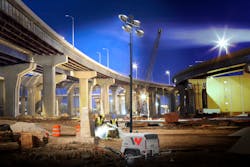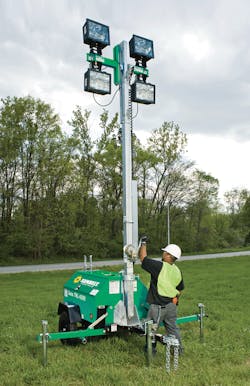When to buy, when to rent light towers
Manufacturers and rental companies offer light tower options that allow workers to select exactly what they need on site.
When choosing whether to buy versus rent, end users should pay precise attention to job requirements and the cost to maintain a light tower. Light tower trends—including a lean toward green energy and LED lighting—also influence their choices.
Managers should first consider job logistics and requirements. Customers usually decide to purchase a light tower if their utilization rate is high, or if they always want a unit in their possession. For long-term or repeat projects spanning six months or more—meaning usage is required between 60 and 70 percent of the time—purchasing may be more beneficial.
“Take a concrete contractor for example,” says Fred Paul, university manager at Wacker Neuson. “Redi-mix trucks can be delayed during normal working hours due to traffic or simply [because of] high demand for concrete.”
In this case, having a light tower ready in-house is invaluable: It reduces downtime and helps ensure low-light jobs are completed efficiently and safely.
“It is typical for contractors to schedule delivery outside of peak hours, which normally fall in darkness,” he says. “The light towers would be used not only to illuminate the placement area, but the haul road, washout area, and all other areas of the site.”
If light tower rental rates exceed the purchase payment, owning them is also a more viable choice on repeat jobs. This is the case for Craig Worrell, CEM, director of fleet operation at Mass Excavation in Alaska. His team experiences six months of “daylight darkness” throughout the year, making it vital to own the majority of light towers used.
“We have to have light towers at every flagging station for highway jobs, and in the lay down yards at our snow removal contracts along with our winter jobs to keep people safe in and around the equipment,” he says. “If we were renting all of them, we would spend quite a bit more than their actual purchase price.”
The type of lighting required also makes a strong case for ownership. Although metal halide bulbs are prevalent in the market based on price, LEDs have made a leap in recent years when it comes to fuel efficiency and running hours. An LED bulb typically guarantees 10,000 hours of use at its full light output, for example, whereas metal halide bulbs lose 50 percent of their light output within the same timeframe.
Even with LEDs rising in popularity, some rental companies do not purchase LED light towers because of higher acquisition costs, according to Vince Hunt, senior product manager at Generac. If a job requires LED bulbs, rentals may be hard to come by in some markets.
“In this scenario it may be best for end users to buy LED light towers instead of renting metal halide,” he says.
LEDs offer many advantages. They require less power than metal halide lights, and they produce better fuel economy, making the total cost of ownership much lower. According to Erin Brown, Doosan Portable Power’s senior product specialist, customers would see a return on their investment between six months and one year after switching from metal halide to LEDs.
“That’s where the payback comes in,” she says. “LEDs use half of the fuel. They’re more expensive, but the payback to the end user is the amount of fuel required to operate the light tower.”
To put the differences into perspective Eric Massinon, business development manager at Chicago Pneumatic, says the group offers a 6kW light tower with a 28-gallon fuel tank, providing 4,000 watts of metal halide lighting for 50 hours. However, after switching the metal halide bulbs out for LEDs, the tower runs for 150 hours.
“It’s the same 28-gallon fuel tank, but with three times the runtime,” Massinon says.
Without LED towers available for rent, this can slow the workflow and force unnecessary operating costs.
“If they went the rental route, customers may even have to purchase and replace metal halide bulbs themselves,” says Hunt. “Buying LED light towers can save several thousands of dollars per year.”
If the job is short (generally less than six months), most manufacturers would recommend renting light towers.
“Renting is more straightforward from a total cost perspective,” says Brown. “The user is generally only responsible for the monthly rental fees and fuel. If the project is relatively short in duration, renting is usually the better option.”
It may also be beneficial to have a combination of owned and rented equipment for projects that require a large fleet for an extended period, according to Griffin Eure, strategic account manager at United Rentals.
“Purchasing light towers ensures quick access and availability,” he says. “However, renting additional units for scale or duration of the project allows fleet managers to reserve capital and gives some agility in the fleet strategy and budget. Plus, renting equipment gives fleet managers and contractors valuable flexibility.”
Kokosing Construction, for example, rents additional light towers based on illumination needs or due to out-of-service machines.
“We typically use a combination of rental and purchase, mainly driven on cost of ownership and operating as well as utilization,” says Tim Truex, equipment area manager. “We have found that it makes sense to own most of the projected hours for this equipment, and rent for short-term needs and fleet shortages.”
Worrell also rents when needed.
“I will rent to fill gaps in the local area where a rental company has access to the units,” he says. “Rentals for us are about filling a gap when we run out of owned units.”
Rental may also be a better option following the industry’s greater focus on green energy.
“Users may take on projects that don’t allow combustion engines on the job site anymore, so they have to use solar-powered or hybrid towers,” says Brent Coffey, product manager at Sunbelt Rentals. “Right now, renting combustion engine towers is still the most common route. But as the industry adapts, we expect to see more transition to alternative fuel options.”
Coffey says that in those cases, it is more efficient to rent light towers for various job requirements.
“Say you’re working on five job sites where there are five different light tower requirements,” he says. “It’s easier for a rental company to provide what you need rather than owning a yard full of them and only using them 20 percent of the time.”
Renting green-friendly light towers also eliminates the need for refueling, an additional cost on the job site.
“Light towers are easily forgotten on job sites,” says Coffey. “Everyone is engaged with the machines that are always running in front of them. The bigger issue is when you have a high volume of them, say several hundred of them to refuel on a job site. That’s a big task to undertake if they are not top of mind.”
Renting solar-powered light towers, for example, is especially useful on jobs in remote places that are difficult for trucks to access for refueling. Most solar light towers operate by photocell—sensors that detect light and enable towers to turn on and off autonomously.
“If you have solar panels to capture the sun, the unit will keep going for a long time without having to worry about getting fuel trucks to do oil changes or maintenance,” says Jeff Hock, Wanco’s VP of operations. “A lot of the time, you can set it and forget it. There’s no operator that has to come up to it and turn it on and off.”
Rental may also be the better option for companies without adequate repair and preventive maintenance resources. With rentals, users aren’t responsible for a light tower’s total cost of ownership or storage and labor costs.
“If you were to make a purchase, you would need to have a technician who is able to make repairs or perform the maintenance, or you would take the light tower to your local dealer for maintenance and repairs,” says Doosan Portable Power’s Brown. “For rentals, usually repairs are managed by the rental company.”
Sunbelt’s Coffey says that even if a site had a technician, they may not be qualified.
“Light towers are not drastically complex machines, but they’re different from what a normal mechanic might work on,” he says. “Even if the expertise is there, maintaining them just adds a distraction to the job site. We have the ability to repair things quickly, whereas a normal retail customer might not have access to that.”
Having additional support on the rental side also reduces downtime.
“We literally take care of everything,” says Coffey. “On a growing number of our light towers, we have telematics on board so we can see whether the unit is running, and we can see exactly where it’s located. If we get a call that something’s not working, regardless of what time it is, we have somebody that’s always on call that will take care of it.”
Rental companies deal directly with the OEMs without having to go through dealer networks.
“If a customer has an issue, we have overnight parts availability from all of our OEMs,” Coffey says. “We diagnose it, and if we don’t have a part on hand, we’ll have it in 24 hours.”

